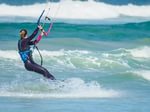The premise is pretty simple: Attach yourself to an enormous kite, strap your feet to a board, and let the wind do the rest. The execution, though—that’s where it gets a bit tricky. With enough practice and plenty of waterproof sunscreen, you can synthesize three extreme water sports—surfing, wakeboarding, and windsurfing—into your new favorite summer hobby.
The Basics
First, get an instructor. You can’t teach yourself to kiteboard without also taking a trip to the ER. First up is a trainer kite, a smaller kite used only on the beach, to get a feel for how you’ll be pulled in the harness. From there, full-size kites range in size from five to 18 square meters. The size you need is determined by your weight, the wind speed (the faster the wind, the smaller the kite) and your experience, so expect to start with something right in the middle. Every kite has inflatable support beams that help the kite spread to catch wind and also keep it (and you) from being pulled under when it hits the water.
In terms of staying attached to the kite, there are two types of harnesses: A seat harness is more like a climbing harness, securing your legs and waist. Most pros (and Maika), however, opt for a waist harness, which increases mobility for tricks and twists. You’ll be fine with either. From there you use the bar to control speed and the board to change direction. And don’t forget your life vest.
The Wind Window
Imagine there is a half-dome directly downwind in front of and above you. The location of your kite in this dome dictates how strongly you’ll be pulled along by the wind. Straight up above you and out to your sides is the neutral zone, where your kite will stay aloft but not pull you. Directly out in front of you is the power zone, where your kite will pull the hardest. In between the two is the aptly named intermediate zone, where you will be pulled hard, but not too hard.
Control
If you feel like you’re going too fast and need to slow down, push the bar up and away from you. The kite will rise straight up out of the power zone and into the neutral zone where it won’t pick up as much wind. This is known as depowering. When you’re ready, pull the bar back toward you.
If you start to lose control and feel like you’re in danger, harnesses have a quick release called a chicken loop located right in front of you between the harness and the bar. Pull the tab on the release to disengage the lines, and the kite will fall harmlessly into the water.
About Our Expert
Maika Monroe is a kiteboarder and actress. The kiteboarding came first. She started at 13, when her father, also a kiteboarder, gave in to years of begging and agreed to teach her. Four years later, she turned pro. She moved to the Dominican Republic to focus on training and soon became one of the top American female kiteboarders. But after sending out audition tapes, Monroe had to cut short her career as a pro athlete when she was cast in 2012’s At Any Price, with Dennis Quaid and Zac Efron. That led to a role in the critically acclaimed horror flick, It Follows, and this summer the 23-year-old California native costars with Liam Hemsworth and Jeff Goldblum in Independence Day: Resurgence (out June 24), the alien apocalypse follow-up to 1996’s alien apocalypse original.
*This article origionally appeared in the July/August 2016 issue of Popular Mechanics.







Recent Comments